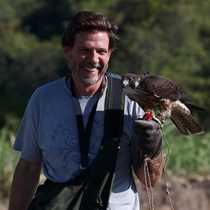Beautiful, clear light so unique to Bartlett Cove greeted early risers. National Park ranger Heidi Herter and Alaska Native Voices interpreter Faith Grant came aboard, and we were soon cruising north up the bay. By breakfast the low clouds began to dapple the still green water with raindrops. Donning rain gear and warm layers we went outside as we slowly passed by South Marble Island. Hundreds of Steller’s sea lions grumbled on rocky beaches. common murres and black-legged kittiwakes dotted the water and filled the air with their calls. We were fortunate to see not only dozens of colorful tufted puffins, but even a pair of the less common horned puffins.
We cruised along, looking intently along the coast for wildlife. Our efforts were rewarded as we nosed into Tidal Inlet, arriving just in time to see a large brown bear swimming across the inlet. The young male brown bear made it to the other side in about ten minutes, and immediately began to forage among the intertidal rocks for a post-swim meal.
North of Tidal Inlet lays Gloomy Knob, a huge outcropping of barren rock. Low lying clouds drifted slowly along, obscuring the rounded summits in wisps of grey. A hoary marmot stood silhouetted against the clouds. Under a protective overhang of rock, a nanny mountain goat rested with her young kid out of the rain. Nearby a bald eagle groomed its rain-drenched eaglet in their nest. An impressively large male brown bear meandered along a rocky beach, weaving in and out of the dense alders along the shore.
Faith told us about the cultural significance of Glacier Bay as we cruised across the west arm of the bay towards the entrance to Johns Hopkins Inlet. This was the first time this season that National Geographic Sea Lion had gone into the inlet. Immense mountains rose steeply above us, their jagged tops peeking through shifting clouds. Numerous glaciers hung suspended in their valleys, blue and mottled with rocks. We picked our way through icebergs that led us like stepping stones towards the face of the glacier. Johns Hopkins is the most active glacier in the park, and her mile-wide face did not disappoint. Ancient ice fell with thunderous booms into the water, sending splashes hundreds of feet into the air.
A day spent cruising up and down the length of Glacier Bay National Park is as humbling as it is impressive. That such a magnificent, rugged, and wild place was carved by ice is at times hard to comprehend. But the beauty of park is impossible to escape, even on the greyest of days.









